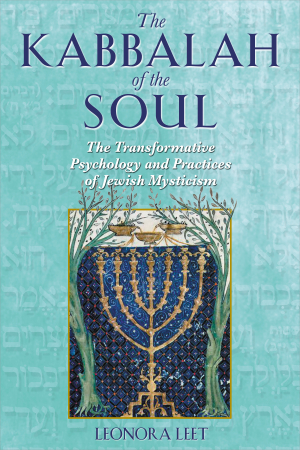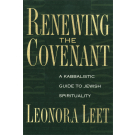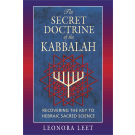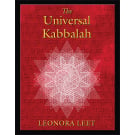The Kabbalah of the Soul
The Transformative Psychology and Practices of Jewish Mysticism
- Pages: 384
- Book Size: 6 x 9
- ISBN-13: 9780892819577
- Imprint: Inner Traditions
- On Sale Date: March 25, 2003
- Format: Paperback Book
• Relates the soul levels of the Zohar to the various paths the soul may travel toward ultimate realization.
• Introduces a new meditative technique called "the Transformative Moment".
Throughout the history of the Jewish esoteric tradition, humankind has been understood to play a pivotal role in the perfection of the cosmos, uniting the finite with the infinite in the perfection of divine personality. Working from an original synthesis of the major kabbalistic traditions of cosmology derived from the Bible, the Zohar, and the school of Isaac Luria, Leonora Leet has erected a new framework for understanding the mechanism of the transformative spiritual work that enables the human soul to reach increasingly higher dimensions of consciousness. This analysis extends the frontiers of Leet's prior works on the Kabbalah to provide a new illumination of human possibilities.
Leet first considers the false temptations of worldly power and pleasure that lead to the fall of the soul and then the means of its redemption. She develops a powerful meditative technique called "the Transformative Moment," whose workings are exemplified by Jacob and Joseph and that allow the individual to progress through all the higher levels of the soul, even possibly to attain the miraculous powers of the legendary spiritual masters. She further correlates the hierarchy of soul levels with Ezekiel's Throne vision to show the various paths the soul may travel toward self-realization: sex, love, power, knowledge, holiness, and unification. The first four paths relate to the four-faced living creatures (Chayot) of Ezekiel's Throne vision--the bull-ox, lion, eagle, and man. The final two paths correlate to the prophet and the envisioned man on the throne he recognizes to be his divine higher self, the knowledge that defines the secret doctrine of the whole of the Jewish mystical tradition culminating in the Kabbalah.
Chapter 1
The Scale of the Soul
Introduction to a New Cosmic Model for Kabbalistic Soul Psychology
Throughout the history of the Jewish esoteric tradition that culminates in the Kabbalah, humanity has been understood to play a pivotal role in the perfection of the cosmos, transforming its original emanations of ever more materialized individuality into such purification of identity as can finally unite the finite with the infinite in the perfection of divine personality. To explicate how humankind can be so centrally involved in the cosmic process, this tradition has developed complex theories of the multidimensional nature both of the human soul and of the cosmos, but it has not been as successful in integrating these two inseparable aspects of experienced reality. This chapter will attempt to synthesize the main traditions of Jewish esoteric cosmology as a framework for the following studies of the human soul and of the mechanisms of transformative spiritual work that, at each of its psycho-cosmological levels, can enable it to reach ever higher dimensions of consciousness.
Before turning to the complex subject of kabbalistic cosmology, we should briefly review the understanding of the soul appearing in the Zohar, the most important work of the Kabbalah, which surfaced in thirteenth-century Spain. This seminal work presents a theory of three soul levels based on the three words used in the Bible to signify the soul: nefesh, ruach, and neshamah. In a discussion of the afterlife, they are hierarchically arranged, “one within the other,” on the two levels of the lower and higher selves:
Three names has the soul of man: nefesh, ruah, neshamah. They are all comprised one within the other, yet they have three distinct abodes. Nefesh remains in the grave until the body is decomposed and turned into dust, during which time it flits about in this world. . . . Ruah enters the earthly Garden (of Eden) and there dons a likeness which is in the semblance of the body it tenanted in this world. . . . Neshamah ascends at once to her place, the region from whence she emanated, and for her sake the light is kindled to shine above. She never again descends to earth. In her is consummated the One who combines all sides, the upper and the lower. And as long as she has not ascended to be united with the Throne, the ruah cannot crown itself in the lower Garden, nor can the nefesh be at ease in its place. . . . Once this is accomplished, however, both the others are united each with its sphere; for all three are one, forming one whole, united in a mystical bond, according to the prototype above, in which nefesh, ruah, and neshamah constitute together one totality.1
The Nefesh is the lowest level and represents the birthright animal or vital soul that cannot by itself survive the decomposition of the body. The higher two levels are personal achievements of soul growth that can survive the disintegration of the vital soul after death, the Ruach apparently subject to the process of reincarnation, which the Kabbalah calls gilgul, while the Neshamah can retain its identity in the divine realm of spirit from which it emanated and, unlike the Ruach, “never again descends to earth.” Where the Neshamah is the divine element in the human soul, the Ruach represents the fully realized human level on which mankind is supposed to be functioning. Isaac Luria, who developed the most influential reformulation of the Zoharic Kabbalah in sixteenth-century Safed, then in Palestine, was later to stress this point. In the words of his foremost interpreter, Chayyim Vital: “for, as we know, it is the ruach that is called ‘human.’ Understand this well!”2 Not only is the Neshamah deemed necessary to complete the human soul and fulfill the potential of its lower levels, but it is also essential for the illumination of the higher realms from which it emanated, and, as we shall later see, its final unification with the Throne of Glory illuminates the very purpose of the cosmos.
To understand the important distinction here made between the Neshamah and the lower levels of the soul as well as the different structure of these Nefesh and Ruach levels, we should turn to the treatment of the soul in the Midrash ha-Ne’lam to Ruth, thought to be in the earliest stratum of the Zohar:3
The Holy One, blessed be He, gave two fine crowns to man, for him to use in this world, namely, nefesh and ruah . . . . the nefesh cannot survive in the body without being stimulated by the ruah, which rests above it.
When man begins to serve and worship his Creator with these two, he is stimulated by a holy stimulus from above, which rests upon man and surrounds him on every side. . . . And what is its name? Neshamah. The neshamah is a higher power than that which is called ruah, because the ruah was provided by the Holy One, blessed be He, for service in this world, while the neshamah always acts as a stimulus for service in the upper realms. . . .
Just as there is a ruah and a nefesh on the right-hand side, on the side of the good inclination, so there is a ruah and a nefesh on the left-hand side, on the side of the evil inclination.4
Chapter 1. The Scale of the Soul
Introduction to a New Cosmic Model for Kabbalistic Soul Psychology
The Tradition of Biblical Cosmology
The Conflict between Zoharic and Lurianic Cosmology
A New Model for Kabbalistic Cosmology
The Music of the Spheres
The Seventh World and the Secret Doctrine of the Kabbalah
Chapter 2. The Fourth-World Transformations of Nefesh Consciousness
A Review of the Cosmic Model
The Early History of the Soul
The Structure of the Nefesh Soul
Temptations of a Fallen Culture
The Transformative Moment: A Therapeutic Form of Meditation
The Future Development of the Soul
Chapter 3. The Fifth World of Messianic and Ruach Consciousness
Introduction
Traditional Messianic Chronology
Stages of Ruach Consciousness
Kabbalistic Texts on Meditation
The Structure of the Ruach Soul
The Ruach Soul Model of Transformative Meditation
The First Level of Ruach Power: Creative Thought
The Second Level of Ruach Power: The Master of Synchronicity
The Third Level of Ruach Power: The Master of Transformation
The Fourth Level of Ruach Power: The Master of Creation
Chapter 4. The Sixth World of Transformative Neshamah Consciousness
The Transformative Moment of Neshamah Consciousness
The Patriarchs
The Tzaddikim
The Partzufim
Chapter 5. The Six Paths to Divine Knowledge
The Six Paths to Enlightenment as Grades of the Soul
The Sexual Path of the Bull
The Love Path of the Lion
The Power Path of the Eagle
The Cognitive Path of Man
The Holy Path of Enoch
The Unifying Path of Metatron
Appendix A. The Practice of Transformative Meditation
Appendix B. The Practice of Transformative Prayer
Notes
Bibliography
Index
Elliot R. Wolfson, Abraham Lieberman Professor of Hebrew and Judaic Studies at New York University, author of Through a Speculum that Shines and other works of Kabbalah scholarship
". . . a work of astounding erudition and truly amazing variety and originality that provides an illuminating, new ‘guide for the perplexed.’"
Philip Beitchman, Ph. D., author of Alchemy of the Word: Cabala of the Renaissance and The View From Nowhere: Essays in Mysticism, Literature and Philosophy
"Leet’s adventurous spirit and erudition--charting new territory for Kabbalistic exploration--deserves an audience of those who take Kabbalah seriously."
Gerald Epstein, M. D., Director, American Institue for Mental Imagery, author of Healing Visualizations and Waking Dream Therapy
"Leet's extraordinary and brilliant investigation offers profound insights into the authentic tradition as it discovers its contemporary relevance. ‘Hallelu-Yah’ !"
Rabbi Itzchak Marmorstein, Educational Director, Mercaz HaRaya Center for Vision
"Continuing the Zoharic and Lurianic traditions, Leet reclaims the soul of Kabbalah to build an inclusive model of personal transformation."
Jason Shulman, Director, A Society of Souls, a school of Integrated Kabbalistic Healing
"This scholarly, highly creative kabbalistic model of interpenetrating levels of soul and cosmos offers a new model for transpersonal psychiatry."
Ann Massion, M.D., Department of Psychiatry, University of Massachusetts Medical School
LEONORA LEET received her Ph.D. from Yale University and was Professor of English at St. John’s University. Her other books on the Kabbalah are Renewing the Covenant and The Secret Doctrine of the Kabbalah.










